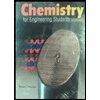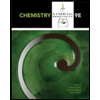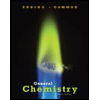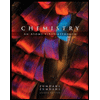of 1 mole of a monatomic gas is increased from 25°C to 300°C. 3.20 One mole of an ideal gas undergoes an isotherma expansion at 300 K from 1.00 atm to a final pressure while performing 200 J of expansion work. Calculate the final pressure of the gas if the external pressure s 0.20 atm. Heat Capacities 3.21 A 6.22-kg piece of copper metal is heated from 20.5° C to 324.3°C. Given that the specific heat of Cu is 0.385 J g1 °C-1, calculate the heat absorbed (in kJ) by the metal. 3.22 A 10.0-g sheet of gold with a temperature of 18.0°C is laid flat on a sheet of iron that weighs 20.0 g and has a temperature of 55.6°C. Given that the specific heats of Au and Fe are 0.129 J g-1 C-1 and 0.444 Jg-1 oc1, respectively, what is the final temperature of the combined metals? Assume that no heat is lost to the surroundings. (Hint: The heat gained by the gold must be equal to the heat lost by the iron.) 3.23 It takes 330 joules of energy to raise the tempera- ture of 24.6 g of benzene from 21.0°C to 28.7°C at con stant pressure. What is the zene at constant pressure? 3.24 The molar heat of vaporization for water is 44.0 kJ mol-1 at 298 K and 40.79 kJ mol- qualitative explanation of th values. molar heat capacity of ben- 1 at 373 K. Give a e difference in these two 3.25 The constant-pressure molar heat capacit y of ni-
of 1 mole of a monatomic gas is increased from 25°C to 300°C. 3.20 One mole of an ideal gas undergoes an isotherma expansion at 300 K from 1.00 atm to a final pressure while performing 200 J of expansion work. Calculate the final pressure of the gas if the external pressure s 0.20 atm. Heat Capacities 3.21 A 6.22-kg piece of copper metal is heated from 20.5° C to 324.3°C. Given that the specific heat of Cu is 0.385 J g1 °C-1, calculate the heat absorbed (in kJ) by the metal. 3.22 A 10.0-g sheet of gold with a temperature of 18.0°C is laid flat on a sheet of iron that weighs 20.0 g and has a temperature of 55.6°C. Given that the specific heats of Au and Fe are 0.129 J g-1 C-1 and 0.444 Jg-1 oc1, respectively, what is the final temperature of the combined metals? Assume that no heat is lost to the surroundings. (Hint: The heat gained by the gold must be equal to the heat lost by the iron.) 3.23 It takes 330 joules of energy to raise the tempera- ture of 24.6 g of benzene from 21.0°C to 28.7°C at con stant pressure. What is the zene at constant pressure? 3.24 The molar heat of vaporization for water is 44.0 kJ mol-1 at 298 K and 40.79 kJ mol- qualitative explanation of th values. molar heat capacity of ben- 1 at 373 K. Give a e difference in these two 3.25 The constant-pressure molar heat capacit y of ni-
Chemistry for Engineering Students
4th Edition
ISBN:9781337398909
Author:Lawrence S. Brown, Tom Holme
Publisher:Lawrence S. Brown, Tom Holme
Chapter9: Energy And Chemistry
Section: Chapter Questions
Problem 9.104PAE: 9.104 An engineer is using sodium metal as a cooling agent in a design because it has useful thermal...
Related questions
Question
3.22

Transcribed Image Text:of 1 mole of a monatomic gas is increased from 25°C to
300°C.
3.20 One mole of an ideal gas undergoes an isotherma
expansion at 300 K from 1.00 atm to a final pressure
while performing 200 J of expansion work. Calculate
the final pressure of the gas if the external pressure s
0.20 atm.
Heat Capacities
3.21 A 6.22-kg piece of copper metal is heated from
20.5° C to 324.3°C. Given that the specific heat of Cu is
0.385 J g1 °C-1, calculate the heat absorbed (in kJ) by
the metal.
3.22 A 10.0-g sheet of gold with a temperature of
18.0°C is laid flat on a sheet of iron that weighs 20.0 g
and has a temperature of 55.6°C. Given that the specific
heats of Au and Fe are 0.129 J g-1 C-1 and 0.444
Jg-1 oc1, respectively, what is the final temperature of
the combined metals? Assume that no heat is lost to the
surroundings. (Hint: The heat gained by the gold must
be equal to the heat lost by the iron.)
3.23 It takes 330 joules of energy to raise the tempera-
ture of 24.6 g of benzene from 21.0°C to 28.7°C at con
stant pressure. What is the
zene at constant pressure?
3.24 The molar heat of vaporization for water is 44.0
kJ mol-1 at 298 K and 40.79 kJ mol-
qualitative explanation of th
values.
molar heat capacity of ben-
1 at 373 K. Give a
e difference in these two
3.25 The constant-pressure molar heat capacit
y of ni-
Expert Solution
This question has been solved!
Explore an expertly crafted, step-by-step solution for a thorough understanding of key concepts.
This is a popular solution!
Trending now
This is a popular solution!
Step by step
Solved in 5 steps with 3 images

Knowledge Booster
Learn more about
Need a deep-dive on the concept behind this application? Look no further. Learn more about this topic, chemistry and related others by exploring similar questions and additional content below.Recommended textbooks for you

Chemistry for Engineering Students
Chemistry
ISBN:
9781337398909
Author:
Lawrence S. Brown, Tom Holme
Publisher:
Cengage Learning

Chemistry & Chemical Reactivity
Chemistry
ISBN:
9781133949640
Author:
John C. Kotz, Paul M. Treichel, John Townsend, David Treichel
Publisher:
Cengage Learning

Chemistry & Chemical Reactivity
Chemistry
ISBN:
9781337399074
Author:
John C. Kotz, Paul M. Treichel, John Townsend, David Treichel
Publisher:
Cengage Learning

Chemistry for Engineering Students
Chemistry
ISBN:
9781337398909
Author:
Lawrence S. Brown, Tom Holme
Publisher:
Cengage Learning

Chemistry & Chemical Reactivity
Chemistry
ISBN:
9781133949640
Author:
John C. Kotz, Paul M. Treichel, John Townsend, David Treichel
Publisher:
Cengage Learning

Chemistry & Chemical Reactivity
Chemistry
ISBN:
9781337399074
Author:
John C. Kotz, Paul M. Treichel, John Townsend, David Treichel
Publisher:
Cengage Learning

General Chemistry - Standalone book (MindTap Cour…
Chemistry
ISBN:
9781305580343
Author:
Steven D. Gammon, Ebbing, Darrell Ebbing, Steven D., Darrell; Gammon, Darrell Ebbing; Steven D. Gammon, Darrell D.; Gammon, Ebbing; Steven D. Gammon; Darrell
Publisher:
Cengage Learning

Chemistry: An Atoms First Approach
Chemistry
ISBN:
9781305079243
Author:
Steven S. Zumdahl, Susan A. Zumdahl
Publisher:
Cengage Learning

Chemistry: The Molecular Science
Chemistry
ISBN:
9781285199047
Author:
John W. Moore, Conrad L. Stanitski
Publisher:
Cengage Learning